February is Healthy Heart Month. To celebrate, I made Focaccia using popped Amaranth. Amaranth is a super nutritious and healthy grain. It has a very low gluten content and is the only grain to contain vitamin C. It is also high in calcium, phosphorus and contains high-quality protein, fiber, iron, and is lysine rich.
Amaranth flour is great when combined with high-protein wheat flour in yeast breads. The grains can also be popped to enhance the flavor and give bread a lighter texture. I had some Amaranth grains so I decided to pop them to see what all the fuss was about. It was fun! I love the mild nutty flavor it brings to this Focaccia.
This bread was an experiment. I started out making one recipe and changed my mind in midstream. I ended up creating my own recipe and I think it turned out pretty well.
Popped Amaranth Focaccia
Adapted from:
Chef Brad’s Amaranth Potato Sourdough Dinner Rolls & Popped Amaranth Focaccia from Cooking with Chef Brad: Those Wonderful Grains II by Brad E. Peterson.
Makes: 2 Focaccias
Sourdough Starter:
- 1 cup starter (I fed my starter the morning before I started this process and let it sit on the counter for 4 to 6 hours)
- 2 cups flour (I used all-purpose)
- 3 tablespoons sugar
- 2 cups water
Focaccia:
- 2 1/2 cups Farina Italian 00 Flour (the original recipe recommended pastry flour but I didn’t have any. You could probably just use all-purpose).
- 1 cup all-purpose flour (approximately)
- 2 cups amaranth, popped
- 1/2 cup water (you might need more water if your starter is firm, but my starter was very wet so I didn’t need to add very much water)
- 1 tablespoon salt
- 2 tablespoons olive oil
- 1 teaspoon active dry yeast (the recipe called for 3 tablespoons of yeast but I was using sourdough so I didn’t think it needed it. It may not have even needed this amount but this was an experiment so I went with it).
Directions:
In the early morning or the day before, remove your sourdough starter from the refrigerator and place one cup in a large bowl. Add the 2 cups flour, 1/4 cup sugar, and 2 cups water. Place in a warm spot and let it set for 8 to 12 hours. I did this the night before I planned to use it and put it in the oven with the light on. I didn’t take a photo of this process.
~~~~~~~~
The next morning, pop the amaranth by placing 1 to 2 tablespoons at a time in a deep pot with no oil. If you put too much in the pot, it will burn. Ask me how I know…
To make sure the pot is hot enough, place in a pinch of amaranth and if it pops, you’re good to go. 1/4 cup of grain yields a cup of popped amaranth. I popped 1/2 cup to yield 2 cups of the popped grains.
See for yourself.
Here is 1/4 cup of amaranth grains.
Here are those same grains popped. Cool, huh! I had fun popping the grains. You have to keep a lid on though or they’ll jump right out of the pan.
When the starter is ready, after 8 to 12 hours, add the 2 1/2 cups of Farina or all-purpose flour to it and mix. Let it sponge for 10 minutes.
Add the popped amaranth, extra yeast (if using), 1 tablespoon of salt, 2 tablespoons of olive oil, 1/2 cup of water (or more if necessary).
Gradually add the all-purpose flour and mix until the dough pulls away from the sides of the bowl. My starter was really wet after 12 hours so I used more flour and less water than the original recipe which called for 2 cups of water.
At this point, the dough was just barely pulling away from the sides but I didn’t want to add anymore flour. So I kneaded the dough in the bowl a few times to get the gluten development started. I used wet hands because the dough was a bit sticky.
Since this ended up being somewhat of a wet dough, I let the dough ferment 1 1/2 hours and folded it once during the bulk fermentation. The consistency of the dough was very easy to work with after it bulk fermented.
After the dough bulk ferments, divide it in two, roll it out and place it on parchment paper to bake freeform on a baking stone or bake it in a pan. I decided to try Jeffrey Hamelman’s method of adding olive oil to a baking pan and then spreading the dough in the pan to bake. I liked this method.
I spread the dough in an 9” x 14’’ pan and had enough left over to fill a 9-inch cake pan as well. I brushed the loaves with olive oil and sprinkled them with dried rosemary and dimpled them with my fingers.
I baked each focaccia in a preheated 400º F oven. I didn’t use a baking stone underneath, I baked them on the middle rack of the oven. I let each loaf bake for a total of about 20 – 25 minutes. I lowered the oven to 375º F about two-thirds of the way through the baking cycle and let them finish baking.
As you’ll notice, the olive oil in the pan gives the sides and bottom a nice brown color and a crusty texture, but the dough within was soft and had some give.
I forgot to add some coarse salt before I baked the focaccia and that’s about the only thing I would do differently next time. I took one bite and decided it needed more salt so I added some to the top.
Here is the crumb shot. I really like the flavor and texture of this focaccia. It’s crunchy on the outside and a little nutty on the inside due to the amaranth. The rosemary adds to the enjoyment.
Since I had two loaves, I decided to share one with my son in college. I shipped him one in a care package. Amaranth is supposed to possess good keeping qualities so we’ll see how well it does.
This was a fun bread to make. I enjoyed popping the amaranth and experimenting with the different flours. I really like the outcome. I’ll definitely be baking bread with amaranth again.
This bread has been YeastSpotted. Please visit Wild Yeast to view all of the lovely breads in the roundup.
Thanks for joining me in the bread-baking blog.
Happy Baking!
Cathy
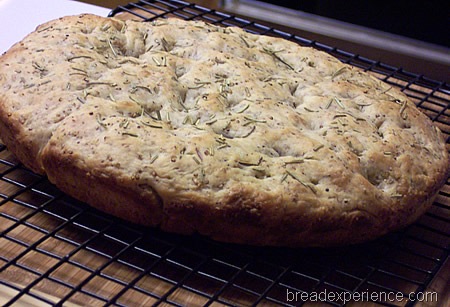
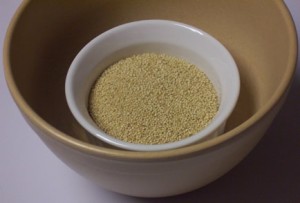
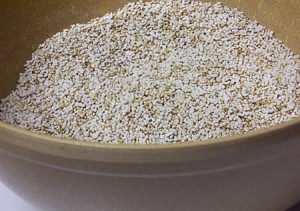
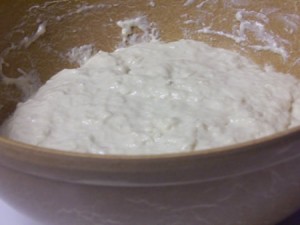
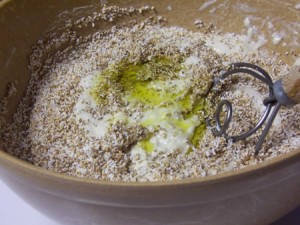
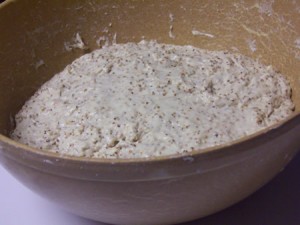
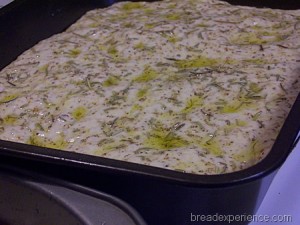
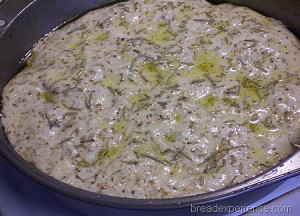
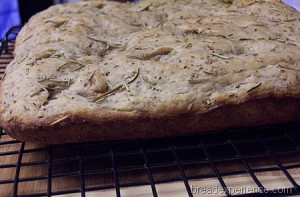
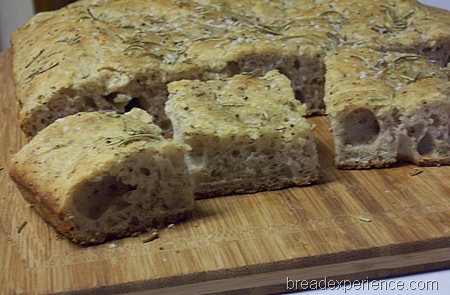
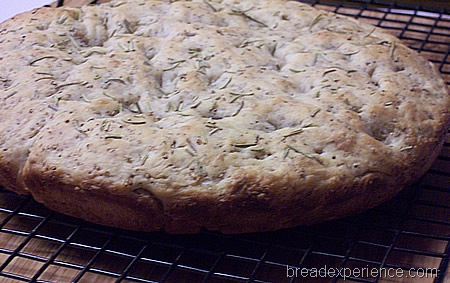
Elwood says
Yummy, I use amaranth and quinoa all the time, but have never popped the amaranth. Sounds really good.
Judy's Bakery & Test Kitchen says
The popping of the amaranth is really fascinating! I never thought of doing that in a bread type recipe.
I have some quinoa, might experiment with that. Thanks for the inspiration.
Melanie says
Your foccacia looks sooooo good!! I love the pillowy, softness of the inside of foccacia. I tried looking for some recipes online that used amaranth, but didn’t find anything I’d want to try. Everything was gluten-free. I’m glad you have some sources that include recipes using it. That’s so cool the way you popped those grains.
Guff says
Very interesting. I make popcorn in the microwave by putting some kernels in a brown lunch bag, folding the top twice, and nuking them on high until the popping slows down. Wonder if that would work with the amaranth.
Cathy (breadexperience) says
That’s a good question Guff. Amaranth grains are really small but it might work. It’s worth a try.
Mendy says
ב”ה
Wow! That’s awesome!
Mary J says
Oh, YUM!! But must leave your blog. The food porn is making me soooo hungry!! Thanks so much for the lovely entertainment!! And recipes. M
Melissa says
Oh Cathy! So many questions! 🙂 So I tried to pop amaranth the other day – thinking it would be a good addition to something, course now I don’t recall what it was! BUT – I failed miserably – I got my pan nice and hot and put in about a Tablespoon — it burnt as fast as you can say Please. 🙁 I shook the pot and all just like for popcorn…….. Maybe I was having a bad day!
So you talk about ancient grains like eikorn and such – is “ancient” grain and “pseudo” grain used interchangeably? My nutritionist says I can have pseudo-grains and he lists things like quinoa, teff, buckwheat, amaranth…….. Was just curious! I’m still looking for that perfect grain free bread recipe! I am going to make almond meal muffins tonight to see how they turn out! But any recipes with just pseudo grains would be awesome! I know they don’t behave like bread so might be tricky. Thanks so much for your blog! Glad I found it!
Cathy says
Hi Melissa, thanks for visiting my blog. Perhaps the pan was too hot and that’s why the amaranth burned. That’s a bummer!
Ancient grains are actually wheat. Einkorn is the most original wheat they have found. Supposedly it hasn’t been hybridized by man or nature. Some people are able to tolerate it better than modern wheat.
The pseudo-grains that you mention are gluten-free so perhaps that’s why you can have them. I like to use different types grains, seeds, and nuts in breads, but my area of focus isn’t on grain-free breads. However, you might find me experimenting with them from time-to-time.
Good luck with the almond meal muffins.
Happy Baking!
Cathy